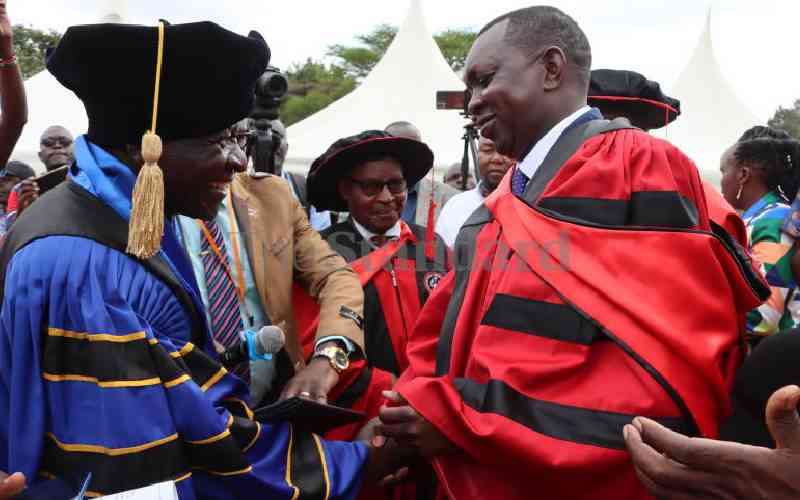BY PASCAL MWANDAMBO
Forget the first meeting that sent your head spinning and your palms sweating. Forget courtship. Forget the engagement ring. In traditional Taita, marriage was an affair between two families and a communal affair from the word go.
“In traditional Taita, parents and close relatives decided which girl would be married to which man and their decision was final. Declining the spouse chosen for you was an abomination,” says Mzee Dishon Mwalui.
Shared ties
Mzee Mwalui says a girl and a boy would be united on the basis of the relationship between the two families. Shared ties normally decided who would marry who. Such ties usually included shared values and common interests that two families believed would be strengthened by marriage.
“Families with divergent interests such as sorcerers and witchdoctors were usually avoided due to clashing social values. So the daughter of a sorcerer who was considered a social misfit would only marry a man from a family with similar character,” the elder says.
He says that one common value the two families would want to cement through marriage was a blood brotherhood locally known as mtero.
“Mtero was a powerful bond between families that was seriously protected and a boy or girl or who declined to be married to a spouse chosen for him or her would be excommunicated from the family,” says Mwalui.
After serious deliberations that lasted several months where the parents to the spouses shared vows and gifts, the marriage plans were made final.
A day was arranged when the bride was waylaid by a group of hired youths who drove her will-nilly to the bridegroom’s home.
Locked up
According to a book on Taita culture, Chuo cha Mizango na Maza ra Kidawida ra Kufuma Kokala by the late Frank Mcharo, the bride would be locked up in a secluded hut while emissaries would be sent to her home to report that their daughter had been ‘stolen’ by the bridegroom’s family.
The emissaries would also be given a fine to pay to the bride’s family as atonement to the supposed anger aroused by the “stealing of the daughter of the soil.”
According to Mzee Mwalui, the bride would be educated on family values by senior women elders while in seclusion, which included values such as taking care of the husband and parenting.
On the other hand, the bridegroom would also be sent into seclusion and educated on values such as taking care of the family and bringing up children in a responsible way.
Stay informed. Subscribe to our newsletter
After the seclusion, the bride and groom would come out of seclusion clean-shaven to mark a new beginning in their lives.
Feasting and drinking
Great celebrations would be held which included performance of mwazindika dances, beer drinking by the elders and feasting on mutton, part of which would be taken to the caves of the ancestors as inducement for them to bless the newly weds with plenty of children who were healthy, virile and fertile.
Bride price was negotiated on the basis of the wealth of the families. This was carefully calculated and paid in installments, which extended up to the time the couple had produced children.
The reason for the careful calculation of prudent bride wealth was to ward off the belief that marriage was not a business transaction but a lasting union between families.
However, one key component of the bride wealth was beer for the elders and uncles to the bride and a goat for the bride’s mother which was known as minga ya kumbo, more like fastening the chastity belt around the mother of the bride after her womb “extended” after childbirth.
Another key component of the bride wealth was minga yefunga mnyango, a kind of compensation for the bride’s family “to lock the door” after their daughter “was stolen”.
The bride price was such a powerful component of marriage such that failure to do so as agreed could invite curses for the new family and future generations.
But on a positive note, those men struggling to get spouses might look back with nostalgia and imagine how they would not have to fight so hard to find a wife.
 The Standard Group Plc is a
multi-media organization with investments in media platforms spanning newspaper
print operations, television, radio broadcasting, digital and online services. The
Standard Group is recognized as a leading multi-media house in Kenya with a key
influence in matters of national and international interest.
The Standard Group Plc is a
multi-media organization with investments in media platforms spanning newspaper
print operations, television, radio broadcasting, digital and online services. The
Standard Group is recognized as a leading multi-media house in Kenya with a key
influence in matters of national and international interest.
 The Standard Group Plc is a
multi-media organization with investments in media platforms spanning newspaper
print operations, television, radio broadcasting, digital and online services. The
Standard Group is recognized as a leading multi-media house in Kenya with a key
influence in matters of national and international interest.
The Standard Group Plc is a
multi-media organization with investments in media platforms spanning newspaper
print operations, television, radio broadcasting, digital and online services. The
Standard Group is recognized as a leading multi-media house in Kenya with a key
influence in matters of national and international interest.






